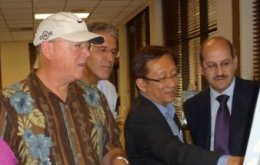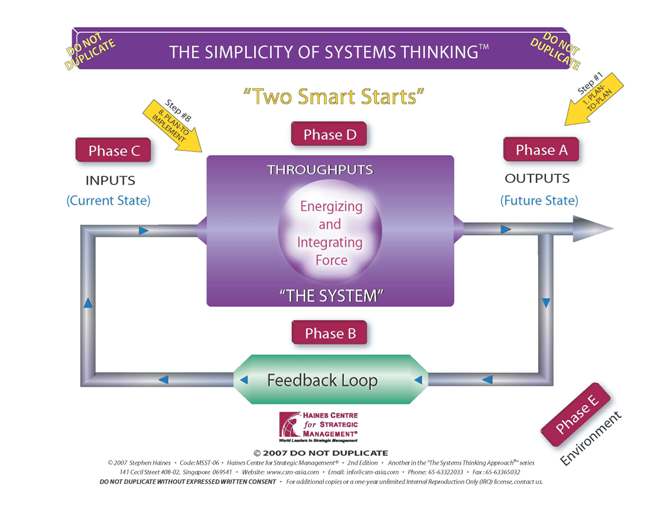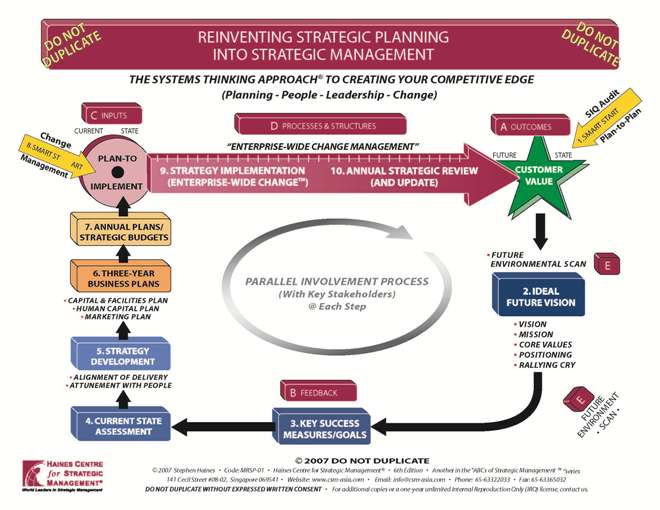Reinventing Strategic Planning

A Research Based 21st Century Success Framework
by Stephen Lin
Reinventing vs Reengineering
There has been much talk in recent years about the term "reengineering this" or "reengineering that." Well, we at the Haines Centre for Strategic Management have over the past 2 decades "re-invented" the Strategic Planning Process. Our work is differentiated frorn reengineering in that our re-inventing process started with a blank sheet of paper. We then completely re-invented a new and more effective Strategic Planning Process that is for the first time based on Systems Thinking. The Strategic Planning Process was then turned it into a Yearly Strategic Management System and Cycle for high performance organizations, with significant fundamental differences from past and outdated strategic planning processes.
What we have done is not just "refining" a Strategic Planning Process, which would be simply fine tuning or tinkering with a few areas. What we have done is instead "Reengineering, a more radical redesign within existing structures, yet with radical and significantly important leaps in effectiveness. We started with Systems Thinking as a frameword and the proverbial blank sheet of paper.
To start, we asked ourselves the number one question from Systems Thinking: "What is the purpose, or goal, or outcome, that we want - in this case in doing Strategic Planning?". In other words, why would anyone or any organization bother to do Strategic Planning?
The answer to that question is now the standard three strategic goals of every organization that wants to achieve business sustainability:
Goal #I: Achieve clarity of purpose;
Goal #2: Ensure successful implementation;
Goal #3: Sustain high performance over the long term.
Once we established and validated these 3 goals, we then asked ourselves: "How should strategic planning be done to best attain these 3 goals?" In other words, what framework best serves strategic planners in achieving the 3 strategic goals of organizations?
We decided that a scientific-based approach would be more universal in its applicability, than empirical based approaches which are usually bounded by the peculiar nature of the geographies, cultures and industries from which they were developed. We thought, and still do think, that this is just common sense. So we decided to use the Systems Thinking Approach which is based on the science of systems thinking. Systems thinking is a set of models and principles that describes the natural world in systems, and helps us to understand how natural systems work and how they interact with each other. In management science, systems thinking offers a way to describe organizations and their business environment in systems, and borrows from "successful" systems in nature the models and principles to help organizations thrive in their business environments.
At the Haines Centre for Strategic Management, we have developed many tools and techniques, templates and models to help organizations to perform better. One of these models is the ABC Model, the input-throughput-output-feedback model, which describes how systems work. We adapted this model for Strategic Thinking and labelled each phase of the Strategic Thinking process from A through E. When each Phase is detailed using the corporate language around strategy, this model becomes the comprehensive framework for Strategic Planning and Management.

The Re-Inventing Process
Once we had the basic ABC Model, we then started to figure out how to use it as an integrated organizing framework for Strategic Planning. In the 1990's the Centre conducted a thorough literature search, and an analysis and comparison of 27 different Strategic Planning and Change models. We also further researched the field of Systems Thinking as the most general, logical way to describe living systems. We continue this literature search today.
In particular, we looked at George Steiner's 1979 landmark book in the field of Strategic Planning. We also drew heavily on the experiences of our founding partners and our other seasoned consultants, from their work with clients as well as their past experiences as senior and top executives in the corporate world which totalled many decades. Our Founder Stephen Haines also drew on the knowledge and experience of lead externaI practitioners in Strategic Planning across North America including Michael Kami of IBM and Xerox fame; Russell Ackoff, a Renaissance Professor at the University of Pennsylvania; Bill Pfeiffer, Len Goodstein, and Tim Nolan, the authors of the Applied Strategic Planning model from UA; and Dr. Henry Migiore, the Dean of Oral Roberts University Business School for over 17 years.
Once the research was concluded, we built our first Strategic Planning and Change models using the ABC Model. Preceding the first finished model, the Partners at that time did a critique and analysis of numerous drafts by many leading practitioners and experts in the field. They used the Delphi Technique over and over again, then tested the model in real time with clients and in training programs.
Only then was it ready to be used as an "integrated organizing framework" for Strategic Planning and Management. That was completed in 1992. However, we fine tune and revise these models each year up to the present, and will continue with this practice of yearly review and enhancement, taking into account experenice, current best practice and client feedback. This continuos improvement of the framework keeps it current and applicable in today's world.
Once we felt we knew enough and had perfected the frameworks successfully with clients for a period of years, we wrote two books on the topic. One is called Reinventing Strategic Planning - the Systems Thinking Approach and the other is called Strategic Planning Simplified. This writing forced us to continue to clarify all points of our practice in order to put them into writing in an elegantly simple way for the reader.

The Results
As a result of our re-inventing, we developed the strategic model that we use as a cornerstone of our practice (see Reinventing Strategic Planning model above).
This Strategic Management System has 15 unique concepts and paradigm changes. These are very different from the popular models we studied even throughout the `90s and still up until today. What we ended up accomplishing is "re-inventing" Strategic Planning into a systems model of a Yearly Strategic Management System that moves beyond planning alone into implementation. It includes a Plan-to-Plan phase and a Plan-to-Implement phase. The steps include team building and leadership skill building as a part of the planning, as well as a Strategic IQ Audit similiar to a yearly financial audit.
Parallel Process
It also includes the need for the process of planning to reinforce the concept that people support what they help create." Thus, there is a need for a Parallel Process that involves all key stakeholders. Buy-in is key to implementation.
Where to Start and Why
Overall, it is a systems approach that starts with a Futuristic Environmental Scan, and then defines the Ideal Future Vision, Mission, Values and Marketplace Positioning you want to achieve (your outcomes/end state first). Other models begin with a Current State Assessment—we do not.
Only after scanning the future environment (Phase E) and defining your Ideal Future (Phase A) should you develop a Current State Assessment (or SWOT) and strategies to "close the gap" and achieve this vision. Without starting with the future, there is no "gap" - just problem solving "more of the same. " The systems approach transcends Strategic Planning into implementation at the annual planning and budgeting level. Then it moves to change management and implementation via our Business Excellence Architecture model. It ultimately leads to updating the Strategic Plan on a yearly basis, another new, yet common-sense, concept.
Experiential Process, Too
At a more macro level, the process itself is very experiential. We believe in helping clients find their own answers and meaning in the plan, not our answers. This is based on adult learning theory where, "adults learn best by doing." We translate this to our common sense concept of "people support what they help create."
Your Competitive Edge
Once clients have been through our process, we find these typical kinds of competitive edges result for them:
1. A Yearly Strategic Management System and Cycle is instituted as a new way to run their company more effectively and more efficiently. We find it focuses the direction of the entire organization from top to bottom.
2. Executives and middle managers develop themselves strategically and conceptually as leaders and build an executive team and teamwork that cascades down through all levels of management. In fact,we find that a strong empowering and values-based culture begins to develop.
3. The typical bottom-line results clients desire show up dramatically in the second year. Great progress is made towards their "Business Excellence" - their vision and achieving their measures of success. Specifics obviously depend on whether the company is in the public, private, or not-for-profit sector. However, all of those who seriously build this Strategic Management System based on their StrategicPlan are well on their way to achieving their Ideal Future Vision. We see them achieve a Quadruple Bottom Line. To wit,(1) not only do we see solid private sector financial results,but we also find theother kinds of bottom-line achievementssuch as (2) increased customer and (3) employee satisfaction, as well as (4) better contributions to society.
4. Ultimately each organization begins to be much clearer on what their competitive "positioning" in the marketplace is and find themselves moving positively in that direction, to the delight of their customers. (Our Star Positioning)
The Centre has re-invented Strategic Planning starting from a blank sheet of paper. We used Systems Thinking and our A-B-C-D-E framework. We researched the 27 different planning and change authors mentioned earlier to figure out how to make surethat it was a research-based and integrated Strategic Management Process. We wanted a new way to run the business in a more strategic way. When clients tailor this system to their needs and institutionalize it in the second year, the competitive edge they seek is on track and positive results flow.
In Summary: A Strategic Management System—"The Imperative for Survival"
Organizations need a Systems Thinking Approach® to a Strategic Management System with a Yearly Cycle to become high performing organizations (not just budgeting cycles).






